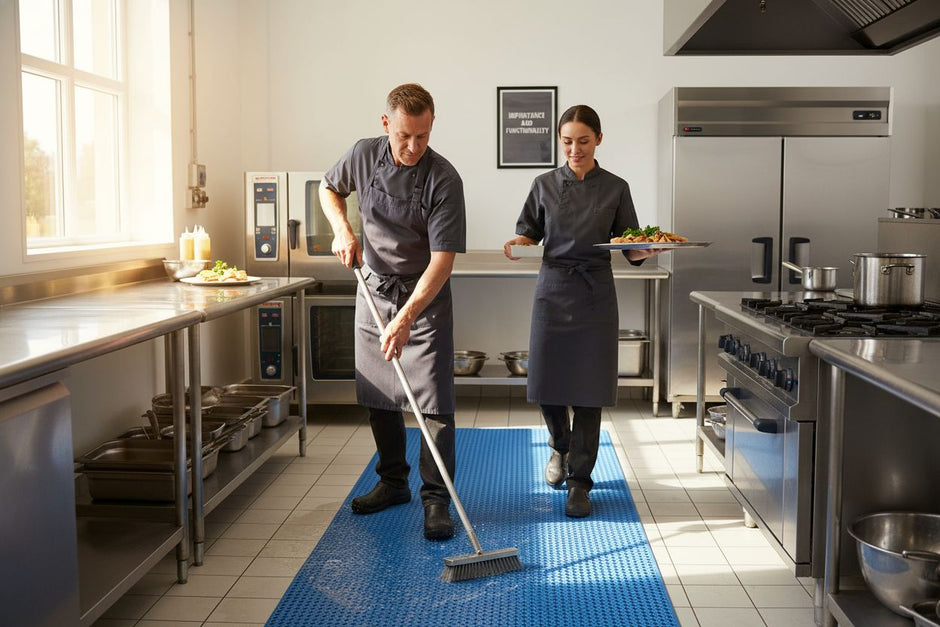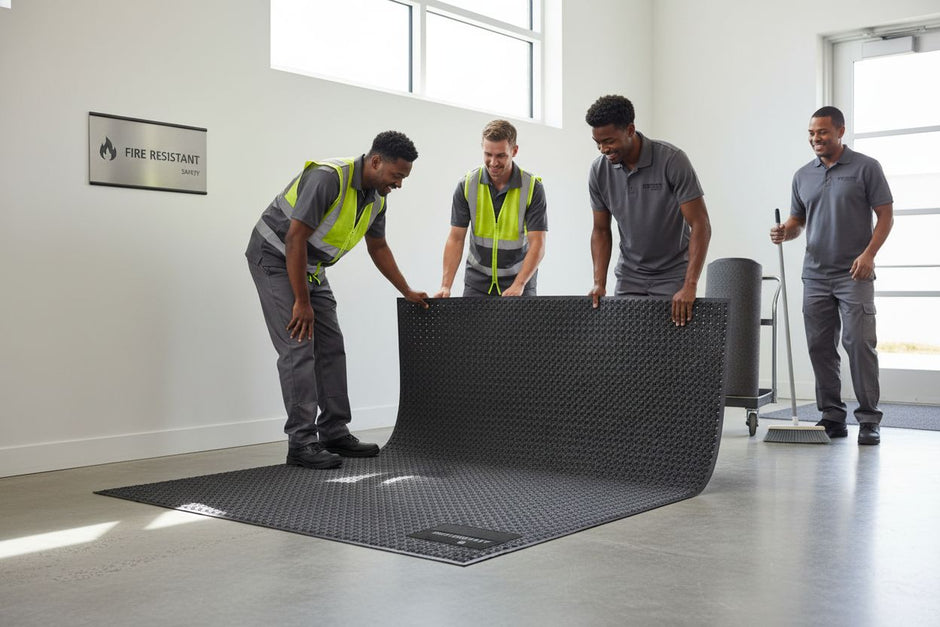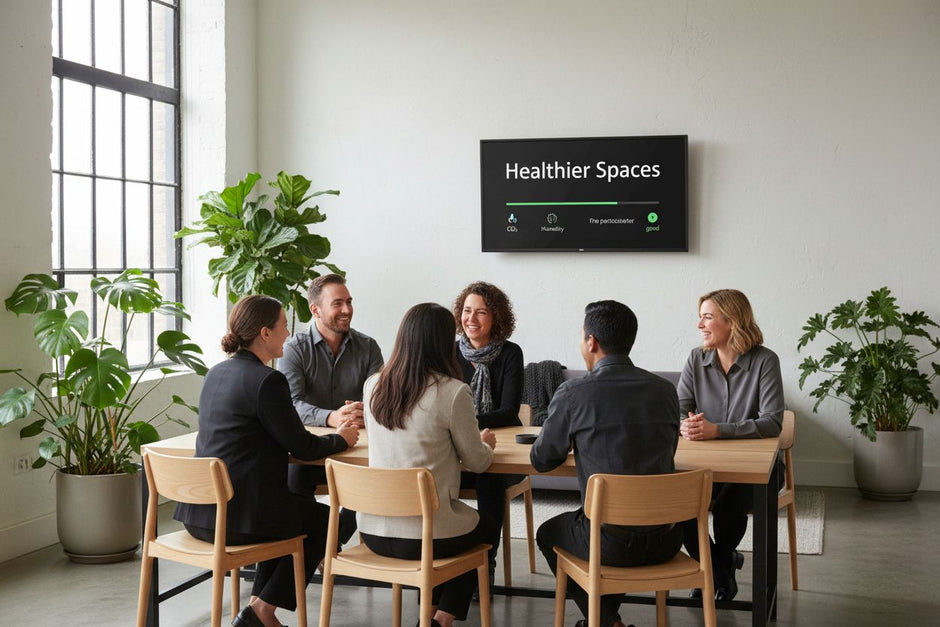Office plants are not just for looks anymore. Studies show that workspaces filled with greenery can increase productivity by up to 15 percent and lower stress for everyone inside. Most people think of potted plants as minor decor, nothing more. The shocker is how these green upgrades are now shaping company culture, employee wellness, and the entire way we think about work spaces.
Table of Contents
- Benefits Of Indoor Landscaping For Businesses
- Top Indoor Landscaping Ideas For Workspaces
- Design Tips For Different Facility Types
- Maintenance Strategies For Lasting Impact
Quick Summary
| Takeaway | Explanation |
|---|---|
| Indoor plants improve employee wellness | Incorporating greenery reduces stress and promotes a calming atmosphere, leading to better mental health. |
| Green environments boost productivity | Natural elements enhance cognitive performance, creativity, and focus, resulting in improved problem-solving. |
| Invest in professional maintenance | Regular care by experts ensures plant health and longevity, maximizing aesthetic and health benefits. |
| Tailor landscaping to facility needs | Different business environments require customized plant solutions for optimal functionality and appeal. |
| Use technology to monitor plant health | Smart systems help track conditions like moisture and light, reducing maintenance efforts and improving care efficiency. |
Benefits of Indoor Landscaping for Businesses
Indoor landscaping has emerged as a strategic approach for modern businesses seeking to transform their workplace environments. Beyond mere aesthetic enhancement, these green interventions offer substantial benefits that directly impact employee performance, organizational culture, and overall workplace productivity.
Psychological and Physical Wellness Impact
Research published in the International Journal of Environmental Research and Public Health reveals compelling evidence about the profound impact of indoor plants on workplace wellness. Indoor landscaping goes far beyond decorative purposes, functioning as a critical intervention for reducing psychological and physiological stress.
Employees working in environments with thoughtful indoor landscaping experience measurable improvements in mental health. The presence of greenery creates a more calming atmosphere, helping to mitigate workplace anxiety and promote a sense of natural connection. Strategic placement of plants can lower cortisol levels, reduce stress responses, and create a more serene working environment.
Physical health benefits are equally significant. Indoor plants contribute to improved air quality by naturally filtering pollutants and increasing oxygen levels. This passive air purification can reduce instances of respiratory issues, allergies, and sick building syndrome, ultimately decreasing employee absenteeism and promoting overall workplace health.
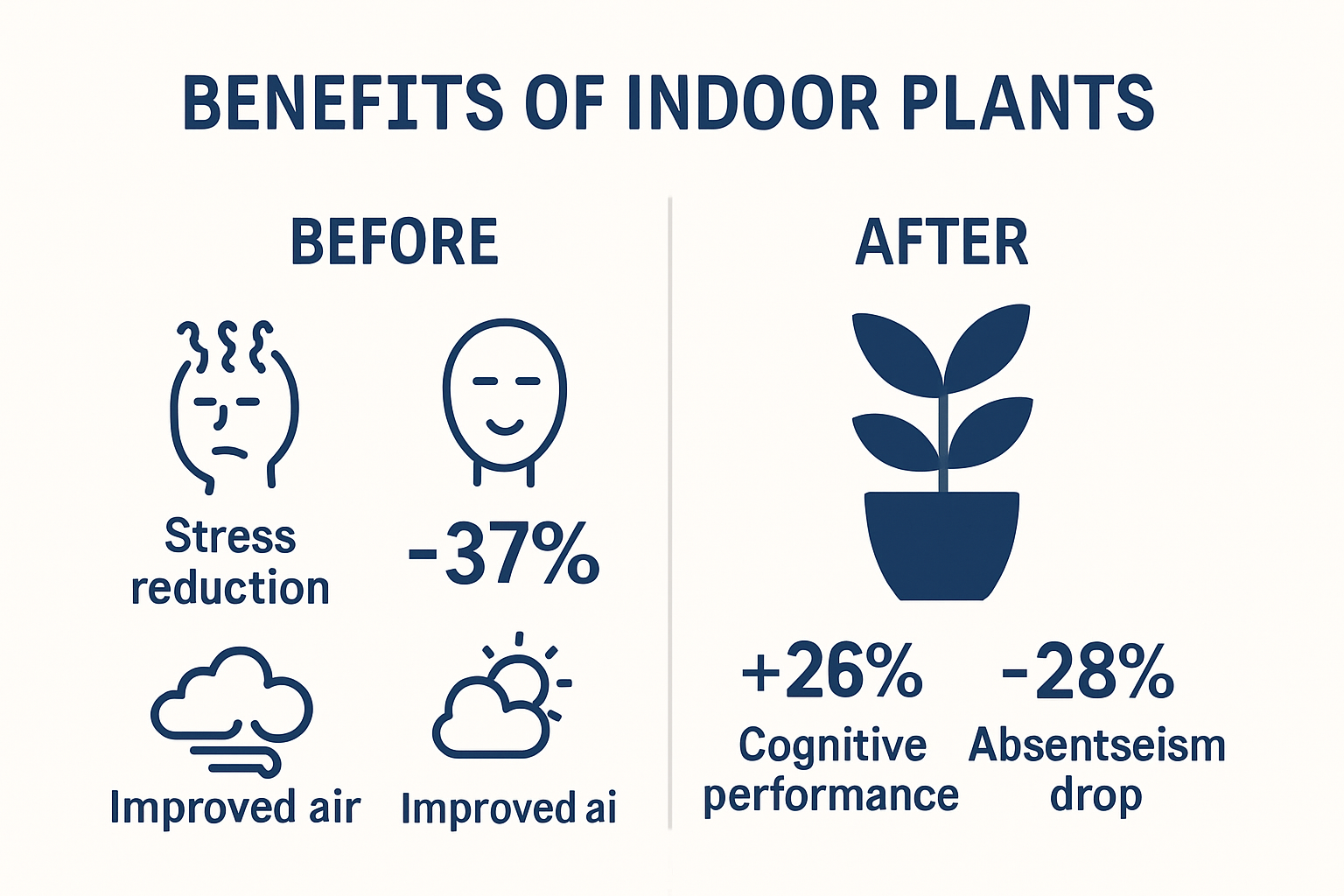
Productivity and Cognitive Performance Enhancement
Beyond wellness, indoor landscaping directly influences cognitive performance. The same scientific study highlighted how green environments stimulate cognitive function, enhance creativity, and improve concentration. Employees working in spaces with natural elements demonstrate increased problem-solving capabilities and higher levels of mental engagement.
The visual and sensory experience of indoor landscaping creates a more stimulating workspace. Green elements break the monotony of traditional office designs, providing visual respite and mental refreshment. This subtle environmental intervention can reset cognitive processes, helping employees maintain higher levels of focus and mental clarity throughout demanding workdays.
Organizational Culture and Brand Perception
Indoor landscaping serves as a powerful statement about an organization’s values and commitment to employee well-being. Companies investing in green workplace designs signal a progressive approach to workplace management. These environments communicate that the organization values employee comfort, health, and holistic work experiences.
Moreover, such spaces become attractive to potential talent. In competitive job markets, workplace design can be a decisive factor for top professionals choosing between employment opportunities. A thoughtfully designed indoor landscape suggests a company that prioritizes innovation, employee welfare, and modern workplace principles.
The aesthetic appeal of indoor landscaping also extends to client and visitor perceptions. Professionally designed green spaces create impressions of sophistication, environmental consciousness, and forward-thinking organizational culture. These visual narratives can subtly influence business relationships and brand image.
While implementing indoor landscaping requires initial investment and strategic planning, the returns manifest in enhanced employee satisfaction, improved productivity, and a more vibrant organizational ecosystem. Modern businesses are increasingly recognizing that workplace design is not just about functionality but about creating environments that nurture human potential.
Top Indoor Landscaping Ideas for Workspaces
Transforming workspaces through innovative indoor landscaping requires strategic design and thoughtful plant selection. Modern businesses have multiple approaches to integrating green elements that maximize aesthetic appeal and functional benefits.
To help businesses choose the most effective indoor landscaping approach, the following table compares key features, advantages, and applications for the main types of workspace landscaping ideas discussed.
| Approach | Key Features | Advantages | Best For |
|---|---|---|---|
| Living Green Walls / Vertical Gardens | Wall-mounted, high visual impact, tech integration | Saves space, major visual appeal, air quality | Limited space, feature walls |
| Modular Plant Zones / Flexible Spaces | Movable planters, adaptable layouts, privacy screens | Highly flexible, supports collaboration | Open offices, changing teams |
| Biophilic Design & Tech Integration | Nature + digital (sensors, AR, smart irrigation), immersive | Data-driven maintenance, innovative image | Tech firms, modern offices |
Living Green Walls and Vertical Gardens
Research from Washington State University demonstrates that strategic plant placement can significantly enhance workplace environments. Living green walls represent a cutting-edge solution for businesses seeking maximum visual impact and spatial efficiency.
Vertical gardens offer multiple advantages beyond traditional plant arrangements. They maximize limited floor space, create stunning visual focal points, and provide comprehensive environmental benefits. These installations can be customized to fit various architectural styles, from minimalist corporate designs to more organic, nature-inspired workplace layouts.
Modern vertical garden systems incorporate advanced technologies like automated irrigation and climate control. These features ensure plant health while reducing maintenance requirements. Companies can select from diverse plant species tailored to indoor conditions, including low-maintenance options like ferns, mosses, succulents, and air-purifying plants like snake plants and pothos.
Modular Plant Zones and Flexible Green Spaces
Scientific research published in PubMed highlights the multifaceted health benefits of integrating indoor plants through strategic design. Modular plant zones offer businesses unprecedented flexibility in workspace landscaping.
These adaptable green spaces can be easily reconfigured to suit changing workplace dynamics. Movable planters with wheels, lightweight partition systems with integrated greenery, and cluster arrangements allow organizations to create dynamic, responsive environments. Such designs support collaborative work models, providing natural dividers that simultaneously enhance aesthetics and functionality.
Some innovative modular approaches include:
- Wheeled planter clusters that can be repositioned for meetings or team restructuring
- Hanging plant systems that create overhead green canopies
- Desk-integrated mini gardens providing personal green spaces
- Movable green screens that offer privacy and natural division
Biophilic Design and Technology Integration
Advanced indoor landscaping goes beyond simple plant placement, embracing comprehensive biophilic design principles. This approach integrates natural elements seamlessly with workplace technology and architectural structures.
Cutting-edge implementations might include digital displays integrated with living walls, smart sensors monitoring plant and environmental health, and augmented reality experiences that interact with green spaces. These technologies transform indoor landscapes from passive decorative elements into interactive, responsive workplace features.
Implementing successful indoor landscaping requires understanding specific workplace needs, light conditions, maintenance capabilities, and organizational culture. Businesses should conduct thorough assessments, consulting with professional botanists and interior designers to create tailored green solutions.
While initial investments in sophisticated indoor landscaping can be significant, the long-term benefits of improved employee well-being, productivity, and workspace aesthetics make these design strategies increasingly attractive for forward-thinking organizations.
Design Tips for Different Facility Types
Indoor landscaping is not a one-size-fits-all solution. Different facility types require unique approaches to plant integration, considering specific functional requirements, spatial constraints, and environmental conditions. Research published in the International Journal of Environmental Research and Public Health highlights the importance of tailored biophilic design strategies across various professional environments.
Corporate Office Environments
Corporate office landscapes demand a strategic balance between aesthetic appeal and professional functionality. Open-plan spaces benefit from carefully curated green zones that create natural divisions without disrupting workflow. Recommended approaches include clustered plant arrangements near collaborative areas, low-profile green dividers between workstations, and statement plants in reception and meeting spaces.
Plant selection for corporate settings should prioritize low-maintenance species that thrive in controlled indoor environments. Options like ZZ plants, snake plants, and pothos perform exceptionally well with minimal care. These plants offer excellent air-purifying qualities while maintaining a clean, professional appearance.
Consider incorporating plants that complement the office’s color scheme and architectural style. Sleek, modern planters in neutral tones work well in contemporary corporate settings, while more organic containers might suit creative industry workspaces.
Healthcare and Wellness Facilities
Healthcare environments require a more nuanced approach to indoor landscaping. Plants must meet strict hygiene standards while providing therapeutic benefits. Recommended strategies include:
- Enclosed plant systems with sealed containers
- Hypoallergenic plant varieties
- Easily cleanable planters
- Strategically placed greenery in waiting areas and recovery spaces
Successful healthcare plant designs focus on creating calming environments. Soft, rounded plant shapes and muted green tones can help reduce patient stress and create a more welcoming atmosphere. Consider plants with proven air-purifying capabilities, such as peace lilies and spider plants, which can help improve indoor air quality.
Educational and Learning Spaces
Educational facilities present unique challenges and opportunities for indoor landscaping. Plants can serve both aesthetic and educational purposes, transforming learning environments into interactive green spaces. Strategies include:
- Classroom botanical learning stations
- Living walls in common areas
- Student-managed small garden zones
- Interactive plant science display areas
In schools and universities, indoor landscaping becomes an educational tool. Plants can be integrated into science curricula, demonstrating ecological principles and sustainable design. Robust, child-friendly plants like succulents and air plants work well in these environments, offering durability and low-maintenance benefits.
The key to successful indoor landscaping across different facility types lies in understanding each environment’s unique characteristics. Factors such as light exposure, temperature control, maintenance capacity, and intended use must guide plant selection and placement.
The table below summarizes recommended plant types and design considerations for different types of facilities, based on the article’s guidance, to help organizations select the right fit for their environment.
| Facility Type | Recommended Plants | Key Design Considerations |
|---|---|---|
| Corporate Offices | ZZ plant, snake plant, pothos | Low maintenance, clean look, air purifying, matches brand |
| Healthcare Facilities | Peace lily, spider plant | Hypoallergenic, enclosed containers, easy cleaning, calming |
| Educational Spaces | Succulents, air plants | Durable, educational use, interactive zones, kid friendly |
Professional consultation with botanical experts and interior designers can help organizations develop customized indoor landscaping strategies. While initial implementation requires investment, the long-term benefits of improved environment quality, employee well-being, and aesthetic appeal make these green interventions increasingly valuable across diverse professional settings.
Maintenance Strategies for Lasting Impact
Successful indoor landscaping extends far beyond initial design and implementation. Sustainable maintenance is crucial for preserving the aesthetic appeal, health benefits, and long-term value of green workplace environments. Businesses must develop comprehensive strategies that ensure plant vitality, workplace safety, and continued organizational benefit.
Professional Maintenance Protocols
Establishing systematic maintenance protocols is essential for indoor landscape sustainability. Organizations should consider developing structured approaches that address multiple critical aspects of plant care. This includes creating detailed schedules for watering, pruning, fertilizing, and monitoring plant health.
Key maintenance considerations include:
- Regular professional plant health assessments
- Scheduled irrigation and nutrient management
- Pest prevention and monitoring
- Seasonal plant rotation and replacement
- Climate and lighting condition tracking
Professional plant management services can provide specialized expertise, ensuring plants remain vibrant and functional. These services typically offer comprehensive care packages that include periodic inspections, precise maintenance techniques, and recommendations for plant optimization.
Technology-Enhanced Monitoring Systems
Advanced monitoring technologies are transforming indoor plant maintenance. Smart sensors and integrated systems can now track critical plant health parameters in real-time, providing unprecedented insights into environmental conditions and plant requirements.
Cutting-edge monitoring technologies enable:
- Automated moisture level tracking
- Light intensity measurement
- Temperature and humidity monitoring
- Early disease and stress detection
- Remote plant health management
These technological interventions reduce manual labor, minimize human error, and provide data-driven maintenance strategies. Organizations can leverage these systems to create more predictive and responsive plant care approaches, ultimately extending the lifespan and effectiveness of indoor landscapes.
Cost-Effective Maintenance Strategies
Implementing sustainable maintenance requires balancing quality care with budgetary constraints. Businesses can adopt strategic approaches that maximize plant health while minimizing operational expenses. This involves selecting low-maintenance plant species, implementing efficient care protocols, and developing internal expertise.
Recommended cost-effective strategies include:
- Training internal staff for basic plant maintenance
- Selecting native and adaptable plant species
- Implementing water-efficient irrigation systems
- Utilizing modular plant systems for easy replacement
- Developing preventative maintenance schedules
By creating a proactive maintenance culture, organizations can transform indoor landscaping from a potential financial burden into a strategic investment. Proper care extends plant longevity, reduces replacement costs, and continuously delivers workplace wellness benefits.
Successful indoor landscape maintenance requires a holistic approach that combines professional expertise, technological innovation, and strategic planning. Organizations must view plant care as an ongoing commitment rather than a one-time installation. By investing in comprehensive maintenance strategies, businesses can ensure their indoor landscapes remain vibrant, healthy, and impactful environments that contribute to organizational success.
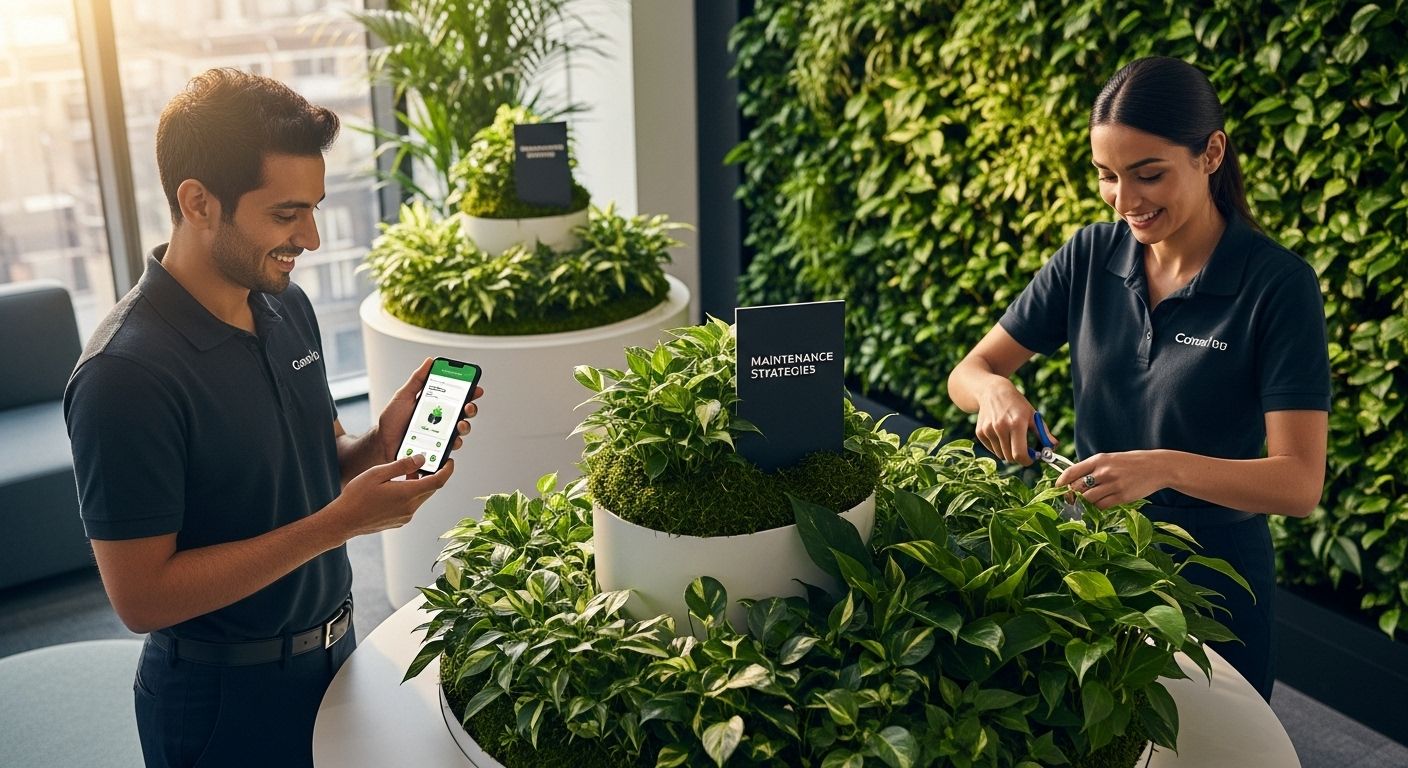
Frequently Asked Questions
What are the benefits of indoor landscaping for businesses?
Indoor landscaping can significantly enhance employee wellness, boost productivity by improving cognitive performance, and positively influence organizational culture and brand perception. Plants create a calming atmosphere, improve air quality, and signal a commitment to employee well-being.
How can plants improve productivity in the workplace?
Research shows that incorporating greenery in workspaces can enhance creativity, mental engagement, and concentration. Natural elements like plants help reset cognitive processes, enabling employees to maintain focus and improve problem-solving abilities throughout their workday.
What are some effective indoor landscaping ideas for modern offices?
Effective indoor landscaping ideas include living green walls, modular plant zones for flexibility, and biophilic design that integrates technology with natural elements. These approaches maximize aesthetic appeal and functionality while supporting employee well-being and collaboration.
How should businesses maintain their indoor plants?
Businesses can maintain indoor plants through regular professional maintenance, utilizing technology-enhanced monitoring systems for conditions like moisture and light, and implementing cost-effective strategies such as training staff and selecting low-maintenance plant species.
Turn Your Indoor Landscaping Vision Into a Safer and Healthier Workspace
You have learned how smart indoor landscaping can boost productivity, wellness, and company image. While plants create an inviting atmosphere and cleaner air, many businesses overlook a key detail: how employees and visitors move through these revitalized spaces. Wet floors from watering, soil debris from planters, and higher foot traffic all create safety and maintenance challenges that impact both comfort and your professional image.
Mats4U.com provides commercial-grade floor mats designed to keep your green workspaces safe and spotless. Our Waterhog and rubber matting solutions trap moisture and dirt at entry points, so plants can thrive without creating new risks. Companies that install durable anti-fatigue mats also support staff comfort and reduce slip hazards in busy indoor gardens, open offices, and health-focused spaces. Create a workspace where health, wellness, and safety work together. Visit Mats4U.com now to find the right mats for your indoor landscaping project. Shop today and take advantage of free delivery on orders over $100. Secure your workplace transformation without delay.



